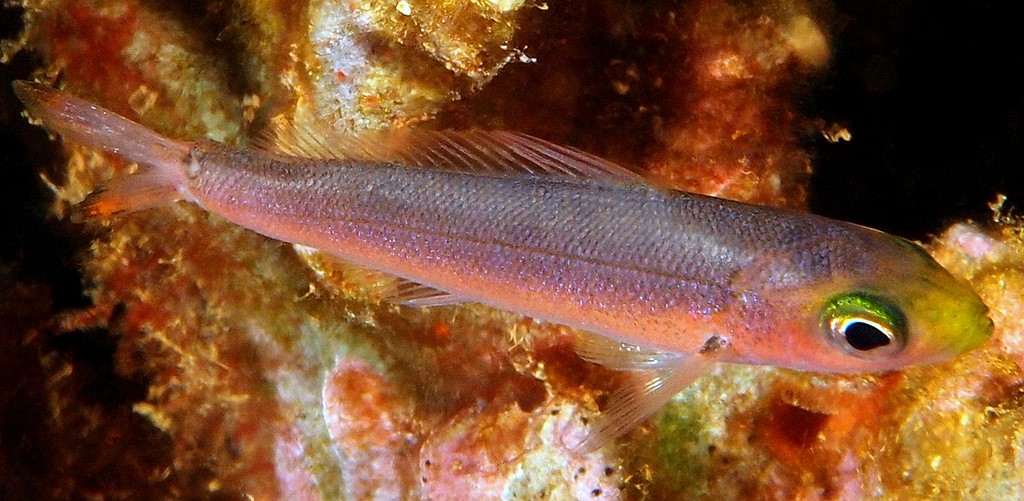PTEROCAESIO PISANG - (BLEEKER, 1853)
Actinopterygii (Gigaclass) > Actinopteri (Class) > Teleostei (Subclass) > Acanthuriformes (Order) > Lutjanidae (Family) > Lutjaninae (Subfamily) > Pterocaesio (Genus)
Caesio rose, Fusilier-banane, Banana fusilier, Bananafish, Bleeker's fusilier, Ruddy fusilier, Fusilero banana, Banan-musketerfisk, Issen-takasago, Takasago, بُندُقِية مَوْز, ചുരൈചാള, 黄带梅鲷, 黄带梅鲷, 斑尾鳞鳍梅鲷,
Synonyme
Caesio pisang (Bleeker, 1853)
-------------------------
Description
Dorsal spines (total): 9-11; Dorsal soft rays (total): 14-16; Anal spines: 3; Anal soft rays: 11-13; Pectoral fin rays: 18-20 (usually: 19); Lateral line scales: 63-71; Upper peduncular scale rows: 10-12 (usually: 11), lower peduncular scale rows: 13-17 (usually: 15); Scale rows above lateral line to origin of dorsal fin: 8-10 to dorsal-fin origin; Scale rows below lateral line to origin of anal fin usually: 14-15; Scale rows on cheek: 4-5; Predorsal scales: 21-29 (usually: 23-26); Body fusiform, elongate and moderately compressed, depth: 3.6-4.8 (usually: 3.9) in SL. Two postmaxillary processes; Small conical teeth in jaws, vomer and palatines. Dorsal and anal fins scaled, the dorsal with about 1/2 of the greatest height of its spinous part covered with scales. Ventrolateral surface of basioccipital with a broad process for attachment of Baudelot's ligament. Post maxillary with 2 processes; Posterior end of maxilla tapered. Head length: 3.0-3.5 in SL; Eye diameter: 3.3-4.3 in HL; Pectoral fin length: 1.1-1.4 in HL. Max. length: 21.0 cm TL, common length: 13.8 cm SL. Depth range: 1 - 100 m.
Color
Variable from dark red to silvery dorsally, paler below, and without stripes along sides, except lateral line darker than background; Snout often yellowish; fins pale; Caudal-fin tips with reddish to black spots, the spots with pale halo.
Etymology
Pterocaesio: from Greek, pteron = wing, fin + from Latin, caesius = blue-grey or bluish-grey.
pisang: from Ikan (=fish) Pisang pisang, local name in Jakarta (formerly Batavia), Indonesia, for this fish; according to Carpenter (1987), pisang means “banana,” apparently referring to its shape.
Original description: Caesio pisang Bleeker, 1853 - Type locality: Ambon Island, Molucca Islands, Indonesia; Jakarta, Java, Indonesia.
Distribution
Indo-West Pacific: KwaZulu-Natal (South Africa), East Africa, Socotra (Yemen), Seychelles and Mozambique Channel east to Philippines and Fiji, north to Ryukyu Islands and Osumi Islands (southern Japan), south to northwestern Australia and New Caledonia.
Biology
Ranges widely around coral reefs, sometimes forming schools with other Pterocaesio species. Feeds on zooplankton in midwater aggregations. Oviparous, with numerous, small pelagic eggs.
Last update: 26, March 2023
Caesio rose, Fusilier-banane, Banana fusilier, Bananafish, Bleeker's fusilier, Ruddy fusilier, Fusilero banana, Banan-musketerfisk, Issen-takasago, Takasago, بُندُقِية مَوْز, ചുരൈചാള, 黄带梅鲷, 黄带梅鲷, 斑尾鳞鳍梅鲷,
Synonyme
Caesio pisang (Bleeker, 1853)
-------------------------
Description
Dorsal spines (total): 9-11; Dorsal soft rays (total): 14-16; Anal spines: 3; Anal soft rays: 11-13; Pectoral fin rays: 18-20 (usually: 19); Lateral line scales: 63-71; Upper peduncular scale rows: 10-12 (usually: 11), lower peduncular scale rows: 13-17 (usually: 15); Scale rows above lateral line to origin of dorsal fin: 8-10 to dorsal-fin origin; Scale rows below lateral line to origin of anal fin usually: 14-15; Scale rows on cheek: 4-5; Predorsal scales: 21-29 (usually: 23-26); Body fusiform, elongate and moderately compressed, depth: 3.6-4.8 (usually: 3.9) in SL. Two postmaxillary processes; Small conical teeth in jaws, vomer and palatines. Dorsal and anal fins scaled, the dorsal with about 1/2 of the greatest height of its spinous part covered with scales. Ventrolateral surface of basioccipital with a broad process for attachment of Baudelot's ligament. Post maxillary with 2 processes; Posterior end of maxilla tapered. Head length: 3.0-3.5 in SL; Eye diameter: 3.3-4.3 in HL; Pectoral fin length: 1.1-1.4 in HL. Max. length: 21.0 cm TL, common length: 13.8 cm SL. Depth range: 1 - 100 m.
Color
Variable from dark red to silvery dorsally, paler below, and without stripes along sides, except lateral line darker than background; Snout often yellowish; fins pale; Caudal-fin tips with reddish to black spots, the spots with pale halo.
Etymology
Pterocaesio: from Greek, pteron = wing, fin + from Latin, caesius = blue-grey or bluish-grey.
pisang: from Ikan (=fish) Pisang pisang, local name in Jakarta (formerly Batavia), Indonesia, for this fish; according to Carpenter (1987), pisang means “banana,” apparently referring to its shape.
Original description: Caesio pisang Bleeker, 1853 - Type locality: Ambon Island, Molucca Islands, Indonesia; Jakarta, Java, Indonesia.
Distribution
Indo-West Pacific: KwaZulu-Natal (South Africa), East Africa, Socotra (Yemen), Seychelles and Mozambique Channel east to Philippines and Fiji, north to Ryukyu Islands and Osumi Islands (southern Japan), south to northwestern Australia and New Caledonia.
Biology
Ranges widely around coral reefs, sometimes forming schools with other Pterocaesio species. Feeds on zooplankton in midwater aggregations. Oviparous, with numerous, small pelagic eggs.
Last update: 26, March 2023
